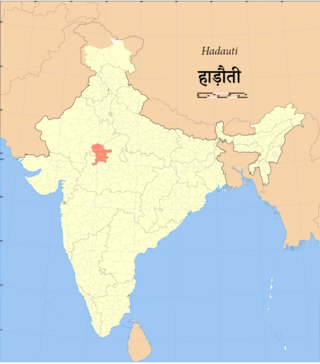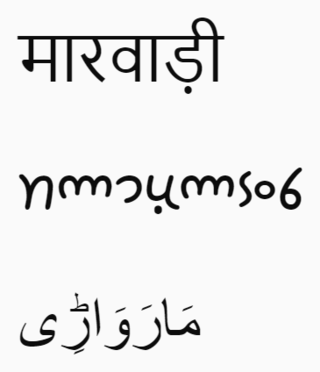
Marwari is a Rajasthani language spoken in the Indian state of Rajasthan. It is also found in the neighbouring states of Gujarat and Haryana, some adjacent areas in Eastern parts of Pakistan, and some migrant communities in Nepal. With some 7.8 million or so speakers, it is the largest language in the Rajasthani languages. Most speakers live in Rajasthan and a few in Nepal. There are two dozen dialects of Marwari.

Bagheli or Baghelkhandi is a Central Indo-Aryan language spoken in the Baghelkhand region of central India.
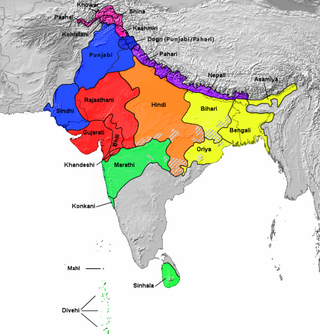
The Northern Indo-Aryan languages, also known as Pahāṛi languages, are a proposed group of Indo-Aryan languages spoken in the lower ranges of the Himalayas, from Nepal in the east, through the Indian states of Jammu and Kashmir, Uttarakhand, Himachal Pradesh and Punjab(not to be confused with the various other languages with that name) was coined by G. A. Grierson.
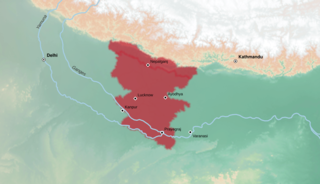
Awadhi, also known as Audhi (औधी), is an Indo-Aryan language spoken in the Awadh region of eastern Uttar Pradesh in northern India. The name Awadh is connected to Ayodhya, the ancient city, which is regarded as the homeland of the Hindu god Rama. It was, along with Braj, used widely as a literary vehicle before being displaced by Hindi in the 19th century.

The Hindi Belt, also known as the Hindi Heartland, is a linguistic region encompassing parts of northern, central and eastern India where various Northern, Western, Eastern and Central Indo-Aryan languages subsumed under the term 'Hindi' are spoken. The term “Hindi belt” is sometimes also used to refer to the nine Indian states whose official language is Modern Standard Hindi, namely Bihar, Chhattisgarh, Haryana, Himachal Pradesh, Jharkhand, Madhya Pradesh, Rajasthan, Uttar Pradesh and Uttarakhand, as well as to the union territory of Chandigarh and the National Capital Territory of Delhi. It is also sometimes broadly referred to as the Hindi–Urdu Belt or Hindustani Belt.

Bhili, IPA:[bʱiːliː], is a Western Indo-Aryan language spoken in west-central India, in the states of Rajasthan, Gujarat, Maharashtra, and Madhya Pradesh. Other names for the language include Bhagoria and Bhilboli; several varieties are called Garasia. Bhili is a member of the Bhil languages, which are related to Gujarati and Rajasthani. The language is written using the Devanagari script.

The Bhil languages are a group of Indo-Aryan languages spoken by around 10.4 million Bhils in western and central India as of 2011. They constitute the primary languages of the southern Aravalli Range in Rajasthan and the western Satpura Range in Madhya Pradesh, northwestern Maharashtra, and southern Gujarat. According to the 52nd report of the commissioner for linguistic minorities in India, Ministry of Minority Affairs, Bhili is the most commonly spoken language of the district of Dadra and Nagar Haveli constituting 40.42% of its total population. Bhili speakers are also significant in the states of Gujarat (4.75%), Madhya Pradesh (4.93%) and Rajasthan (4.60%).

Rajasthanilanguages is a group of Indo-Aryan languages and dialects spoken primarily in the state of Rajasthan and adjacent areas of Haryana, Gujarat and Madhya Pradesh in India. There are also speakers in the Pakistani provinces of Punjab and Sindh. Rajasthani is also spoken to a lesser extent in Nepal where it is spoken by 25,394 people according to the 2011 Census of Nepal.
Malvi or Malwi, is an Indo-Aryan language spoken in the Malwa region of India. It is closely related to Rajasthani.
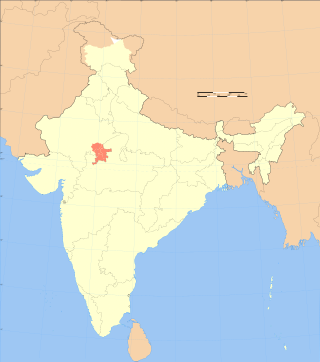
Hadoti is a region of Rajasthan state in western India, which was once called the Bundi Kingdom. The biggest cities are Jhalawar and Kota. It includes the districts of Bundi, Baran, Jhalawar and Kota and is bounded on the west by the Mewar, on the northwest by Ajmer regions of Rajasthan, and on the south by the Malwa, on the east by the Gird regions of Madhya Pradesh state.

Jhalawar district is one of the 33 districts of Rajasthan state in western India. The historical city of Jhalawar is the administrative headquarters of the Jhalawar district. The district is bounded on the northwest by Kota district, on the northeast by Baran district, on the east by Guna district of Madhya Pradesh state, on the south by Rajgarh district and Agar Malwa district of Madhya Pradesh state and on the west by Ratlam district and Mandsaur district of Madhya Pradesh state. The district occupies an area of 6219 km². The district is part of Kota division. To know more about Jhalawar City
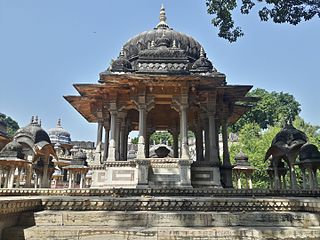
Kota District is a district of the state of Rajasthan in western India. The city of Kota is the administrative headquarters of the district.

Bundi is a district in the state of Rajasthan in western India. The city of Bundi is the district headquarters. It has an area of 5,550 km2 and a population of 1,110,906. It is divided into 5 tehsils which are: Bundi, Hindoli, Nainwa, Keshoraipatan and Indergarh.

Dhundhari is a dialect of Rajasthani spoken in the Dhundhar region of northeastern Rajasthan state, India. Dhundari-speaking people are found in four districts – Jaipur, Sawai Madhopur, Dausa, Tonk and some parts of Sikar and karauli district
Aklera is a town and a municipality in Jhalawar district in the state of Rajasthan, India. It has a rock-strewn, scrub-covered terrain, occasionally bright with fields of poppies and citrus-green groves of oranges. Lying in the south-eastern region of Rajasthan at the edge of the Malwa plateau, Aklera area has rocky but water-laden verdant landscape, unlike much of Rajasthan.
Baran is a city in Baran district of the Indian state of Rajasthan. It is a municipality and the district headquarters of Baran district, famous for its 11th century Bhand Devra Temple on banks of Ramgarh crater. It is 339km from the state capital Jaipur near Kota city. Three large rivers, Parban, Parbati, and Kalisindh, flow through the district.
Ahirwati is an Indo-Aryan dialect of India. It is spoken within the Ahirwal region located to the south-west of the capital Delhi. It belongs to the Rajasthani language group and is commonly taken to be a dialect of Mewati, but in many respects it is intermediate with the neighbouring varieties of Bangru and Bagri, and is especially close to Shekhawati.
The Punjabi dialects and languages or Greater Panjabic are a series of dialects and languages spoken around the Punjab region of Pakistan and India with varying degrees of official recognition. They have sometimes been referred to as the Greater Punjabi macrolanguage. Punjabi may also be considered as a pluricentric language with more than one standard variety.
The Deshwali, or sometimes pronounced Deswali, are Hindu Meena in the state of Madhya Pradesh and Muslim Jat community found in the state of Rajasthan in India. A small number of Deshwali are found in the city of Hyderabad, Jharkhand.

The following outline is provided as an overview of and topical guide to Rajasthan:

